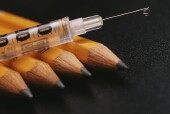
MONDAY, June 10 (HealthDay News) — Offering flu shots at elementary schools could reduce the number of flu cases and deaths among children, a new study suggests.
Vaccination is the most effective way to protect children aged 6 months and older against seasonal flu, but vaccination rates among American children are low. Only about 40 percent of children received a 2012-2013 flu vaccine, according to the U.S. Centers for Disease Control and Prevention.
About 90 percent of children who died from flu during 2012-2013 were not vaccinated, the CDC noted.
The study, conducted in late 2009, included 32 elementary schools in the Rochester, N.Y., area. Two flu vaccination clinics were held four weeks apart at 21 of the schools, while no vaccination clinics were held at the 11 other schools.
The flu vaccination rate among students at the schools where vaccination clinics were held was 13 percent higher than among students at the schools that did not have vaccination clinics, the investigators reported in a recent issue of the journal Vaccine.
“The flu is a disease with high probability of reaching epidemic levels even though we have an effective vaccine. Our goal is to find ways to ensure that the best prevention is as accessible as possible,” study author Byung-Kwang Yoo, an associate professor of public health sciences at the University of California, Davis, said in a university news release. Yoo was with the University of Rochester when the study was conducted.
Children’s flu shots are typically given in primary care doctors’ offices, but they “may not have the capacity to vaccinate all U.S. children against seasonal influenza,” Yoo said. “If the CDC’s recommendations were followed, primary-care offices would have to accommodate 42 million additional patient visits during the five-month window for each flu season.”
That’s why it’s important to find ways to expand children’s access to flu shots, he added.
More information
The U.S. Centers for Disease Control and Prevention has more about children, the flu and the flu vaccine.

